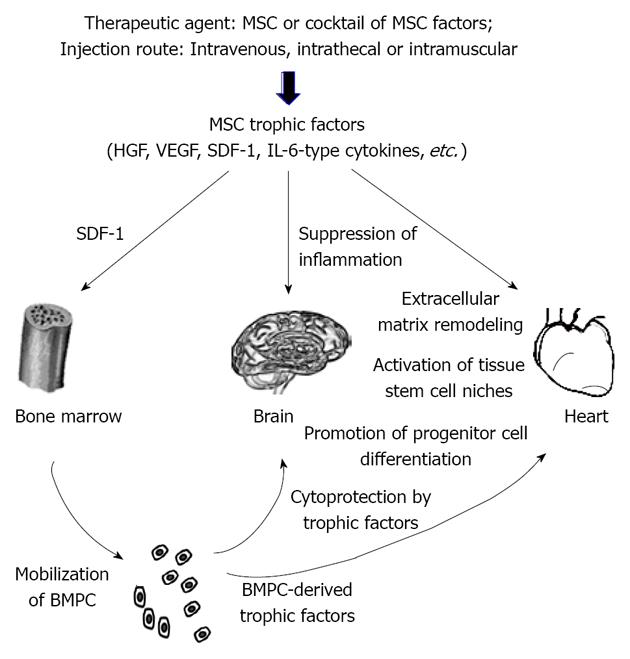Copyright
©2012 Baishideng Publishing Group Co.
World J Stem Cells. Dec 26, 2012; 4(12): 120-124
Published online Dec 26, 2012. doi: 10.4252/wjsc.v4.i12.120
Published online Dec 26, 2012. doi: 10.4252/wjsc.v4.i12.120
Figure 1 Current model of mesenchymal stem cell therapy for brain and heart regeneration.
Mesenchymal stem cell (MSC) therapies for brain and heart repairs have been conducted using either MSC or MSC-derived trophic factors. Successful trials have been obtained based on multiple injection regimens, such as intravenous (for brain and heart), intrathecal (for brain), and intramuscular (for heart) administration routes. Major MSC trophic factors that have been found to be critical in mediating tissue regeneration include hepatocyte growth factor (HGF), vascular endothelial growth factor (VEGF), stromal cell derived factor (SDF)-1, and interleukin (IL)-6-type cytokines. The SDF-1/CXCR4 axis has been found to mobilize bone marrow progenitor cells (BMPC). These heterogeneous BMPC populations are also capable of producing trophic factors, which likely act in concert with MSC trophic factors in suppressing tissue inflammation, normalizing extracellular matrix remodeling, promoting cell survival, activating local stem cell niches, and directing progenitor cell differentiation. In addition, myocardial recruitment of BMPC after MSC therapy has been documented.
- Citation: Lee T. Stem cell therapy independent of stemness. World J Stem Cells 2012; 4(12): 120-124
- URL: https://www.wjgnet.com/1948-0210/full/v4/i12/120.htm
- DOI: https://dx.doi.org/10.4252/wjsc.v4.i12.120









